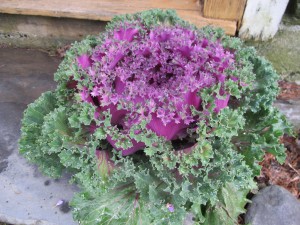Plants for the Front Porch
We New Englanders have a long tradition of doing something to brighten the approach to our front door. In winter it’s a nice green wreath; my grandmother liked red geraniums in a pot by the door all summer; in fall, pumpkins and chrysanthemums are traditional decorations. Three common decorative plants are available for purchase at farm stands now – and worth a look.
Chrysanthemums are very popular, and are readily available in a wide range of colors. I treat them as annuals even though some are touted as perennials. I once estimated the number of buds and blossoms on a potted “mum”. By counting and multiplying I arrived at an estimate of 300 blossoms on a plant that was perhaps 18-inches across. Phenomenal. But if I had planted it in the ground and it came back the next spring, I would have gotten just a small fraction of the number of blossoms the following year. Why? The growers pinch back the stems at least twice to make the plant branch again and again. I don’t have the patience to do so.
A few tips about keeping mums happy. First, they have a large number of blossoms and leaves for the size of their pots. On a crisp fall day a mum loses a lot of water, especially on a sunny doorstep. You probably should water daily, or every other day. If yours comes in a peat pot, which many do, the soil or potting mix will dry out even faster than if it’s growing in a plastic pot. I find that submerging the pots in a big container of water and holding them down until they stop bubbling is the best way to get the roots full hydrated. Or transplant them to self-water containers that have water reservoirs to prevent roots from drying out.
Secondly, if you want to plant your mums in the ground, be careful at planting time: the branches are often very brittle. It’s always disappointing to me when I break off a big section of a mum before it can even strut its stuff for a moment. Usually I just leave my mums in their pots and arrange them by the front door.
If I do plant my mums, I endeavor to plant them deep enough so that I can cover the root ball with an inch of real soil (they are planted in a peat-based growing mix that dries out very quickly). And although you can plant the peat pots directly in the ground, tear off the top 2 inches of pot so that it won’t be sticking up and wicking water away. Remember, a dry mum is an unhappy mum. Frost seems a long way away now, but remember to cover mums when hard frost comes, or bring the pots indoors. They survive light frost nicely.
Another great fall doorstep plant is decorative cabbage or kale. I just bought a big fat one at a farmers market recently, and it will look great all fall, assuming I don’t let it dry out. Last year I started a couple of dozen decorative kales from seed, but was disappointed that they stayed smaller than those generally sold, and bolted in the heat of summer. Huh. The professionals seem to have tricks I do not. I had mine in the ground, not pots, and had planned on transplanting them into nice containers after Labor Day, but ultimately I didn’t think them worthy of moving to the front of the house.
Decorative kale generally has dark green or purplish leaves on the outside, and pink, white or light purple inside. I’ve read that they are, indeed, edible, but are tough and leathery; why bother when edible kale is so easy to grow and tasty? Another great feature of decorative kale is its ability to survive frost. It will not even blink when temperatures drop down into the teens, assuming that your plant has seen temperatures in the twenties and has had time to get used to cold weather. I’ve read that they will survive temperatures as low as 5 degrees without harm.
The last of the fall porch plants are the short asters commonly available in blues and purples, and occasionally in white. Like the mums, these have been pinched back to stimulate the production of more blossoms – and to keep them short. Most are winter hardy, and I have planted them in the ground and let them come back for a second show the next year. But instead of being under a foot tall, they were at least 18 inches tall and only had a few blossoms. I never got around to pinching them back. Nice in the second year, but not dramatic. I usually prefer to buy new plants and let someone else do all the hard work.
Even if you have some new mums on the porch, don’t forget about your window boxes and planters full of annuals. Yes, they may look bedraggled now, but with a little care you can give them new life. Deadhead blossoms, cutting back stems several inches below those tired seed heads. This is tedious, but worthwhile. And give those annuals a burst of energy with some liquid fertilizer. I use a liquid fish mix, but there are plenty of choices, and almost anything will help.
When I see a nice pot of flowers on a neighbor’s porch I always think, “How nice. She is blessing us all with a glimpse of beauty as we go by.” I try to do my part in doing the same, and hope you will, too.
Henry Homeyer is a gardening coach, garden designer and the author of 4 gardening books. His Web site is www.Gardening-guy.com.



